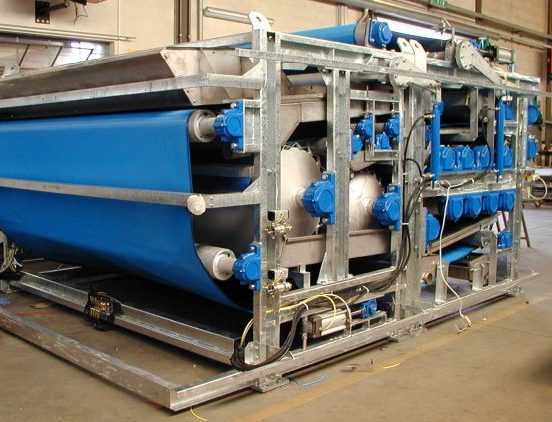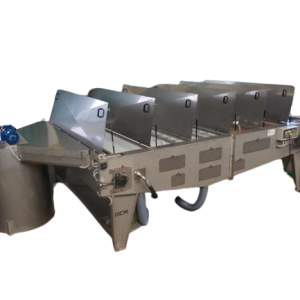Description
Belt filter press PN is a tried and tested device for dehydrating both organic and inorganic sludge using medium and high pressure. These balers feature three efficient dehydration levels – a gravity zone, a wire mesh zone and a baling zone with 7 or 11 rolls. Such a design guarantees a high sludge dewatering effect with low energy consumption, and various additional options allow you to adapt the filpress to your different needs and sludge properties. It is an efficient device for municipal and industrial sludge dewatering and has the following advantages:
- Hydraulic performance and low energy consumption. Belt filter press PN is characterized by high hydraulic performance, which means that it can effectively manage the sludge dewatering process with minimal energy consumption.
- Integrated sludge compactor. The ability to integrate a cascading sludge compactor, if needed, provides great practicality and efficiency. This allows you to optimize the use of the device and save a lot of space and money, since there is no need to install additional multiplexers.
- Wear resistance and durability. Due to the hot-dip galvanized steel or stainless steel body and small revolutions, the belt filter press is wear-resistant and low-maintenance.
- Automatic polymer dosing system. The possibility of choosing an automatic polymer dosing system ensures the optimal amount of polyelectrolyte during the process. This allows efficient control of the flocculation and sludge dewatering process and saves operating costs.
- Easy maintenance and service. Belt balers are robust in design and with easily accessible parts. This enables efficient and quick performance of the necessary service work and ensures the continuous smoothness of the process.
- Low noise level. This press is characterized by a low noise level, which is important for the comfort of the working environment. Low noise increases the work efficiency of employees and reduces the disturbance of the work environment.
- Adaptability. The belt filter press is designed to be used in different wastewater treatment and industrial applications. This will allow you to choose the most suitable solution according to your specific needs, sludge composition and desired performance. Various additional options allow you to adapt the fil press to your different needs and sludge properties.
How it works
This device operates on a comprehensive operating principle that includes automatic function adjustments for maximum performance and efficiency. After the sludge is pumped into a dynamic or static mixer, it reacts with a flocculant solution of the appropriate concentration during mixing. Sludge fine solids (or suspended solids) condense into a larger floc mass, and material water and surface water are separated into free water. As the filter belt moves forward, the material is further transported and spread on the porous belt in the gravitational pre-drainage zone, and the separated free water under the influence of gravity flows into the water tank from where it is later returned to the process. The sludge mass, traveling through the long gravity zone, thickens and after passing the wire zone, enters the pressing zone with the porous roller. The distance between the upper and lower filter belt gradually decreases and the sludge mass begins to be subjected to a slight pressure. Filtrate begins to flow from both sides of the filter belt and the pressure gradually increases. As the filter belt with adjustable tension force and the roller and pressure shaft continuously increase the pressure and shear force, the water in the sludge is continuously pressed, and the sludge is gradually pressed more and more strongly. After passing through the high pressure zone, it becomes drained and separated by the scraper plate falls into a container or conveyor. The microparticles in the pores of the filter belt are cleaned with high-pressure washing water and a roller brush, so that they continue to be clean and enter the next stage of the dehydration cycle.
Specification
Komunalinio ir pramoninio dumblo dehidratacija vidutiniu ir aukštu slėgiu
| Modelis |
PN50 |
PN80 |
PN100 |
PN120 |
PN150 |
PN170 |
PN200 |
PN220 |
PN250 |
PN270 |
PN300 |
| Komunalinio dumblo našumas (3% SM) ms/h |
3-5 |
5-8 |
6-10 |
8-12 |
10-15 |
11-17 |
14-20 |
15-22 |
16-25 |
18-27 |
20-30 |
| Juostos plotis mm |
600 |
900 |
1100 |
1300 |
1600 |
1800 |
2100 |
2300 |
2600 |
2900 |
3100 |
| Juostų plovimas ms/h |
4.6 |
6.2 |
8.2 |
9.8 |
11.9 |
13.5 |
16.4 |
18.3 |
20.0 |
21.9 |
24.6 |
| Juostinio preso galia kW |
2.6 |
2.6 |
3.3 |
3.3 |
4.1 |
4.1 |
5.7 |
5.7 |
5.7 |
7.3 |
7.3 |
| Plovimo siurblio galia kW |
4 |
4 |
5.5 |
5.5 |
7.5 |
7.5 |
11 |
11 |
11 |
13.5 |
13.5 |
| Tuščio svoris kg. |
3000 |
3400 |
4000 |
4500 |
5000 |
5400 |
8000 |
9000 |
10000 |
11500 |
13000 |
Šiame pristatyme pateikti techniniai duomenys yra tik orientaciniai ir turi būti nustatomi kiekvienu konkrečiu atveju. Galimi techniniai pakeitimai.
Application and fields of activity
Sludge dewatering belt press is applied
- Municipal and industrial wastewater.
- Textile printing and dyeing.
- Electroplating industry.
- Paper production.
- Leather processing
- Beer industry.
- Food processing industry.
- Oil refining.
- Chemical industry.
- Pharmaceutical industry.
- For dewatering sludge from ceramics and other industries.








